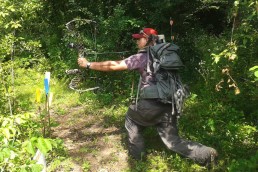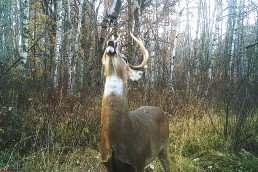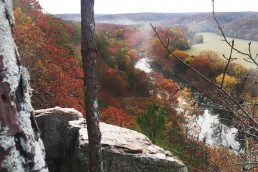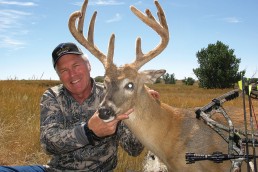Changing Times in the Bowhunting World
SHARE THIS POST
I officially became a bowhunter in 1986. My husband introduced me to archery when we began dating so that we’d have an activity in common. He never nudged me toward the line of bowhunting—I stepped over it voluntarily and it turned out to be a giant jump for me.
In 1992, I became a volunteer bowhunter education instructor for the Minnesota DNR. I joined a team where I assisted in presenting classes around the St. Paul, Minn., metro area. As I became more comfortable with the material and as my field experience gradually grew, I moved into becoming a lead instructor with a “team” of my own.
Minnesota is not one of the 14 states where completion of the course is mandatory in order to purchase an archery license. The exception to that would be if a bow hunter wanted to be part of an urban deer removal project such as those organized by the Metro Bowhunters Recourse Base (MBRB), then bowhunter safety certification is required. Becoming an outdoors woman also requires completing the class before participating in their mentored turkey hunts.
The education program in Minnesota is offered as a service to those wanting more information on bowhunting or to acquire certification to hunt in other states or countries where it is required. Since these classes became available in Minnesota, nearly 23,000 bowhunters have been certified. Hunter education is offered in all 50 states, 10 Canadian provinces and 13 countries.
In the past 23 years I’ve seen many changes in the program beyond the obvious evidence of more grey hair among my fellow instructors. If a program is to remain relevant, then it must continually be updated.
Class size
The most significant change I’ve seen over the years is in class size. Enrollment kept increasing mainly because each year more states require bowhunters to have proof that they’ve completed the safety course before they are issued a hunting license. Currently 14 states, two Northwest Territories and one Canadian province require this proof of competency. The most recent surge in class size, in my opinion, has been due to the interest in metro culling projects.
Age
I’m definitely seeing more kids taking these classes. Much of the thanks needs to go to the National Archery in Schools Program (NASP) for piquing the interest of some of these youngsters to take that next step towards the woods. There are over 500 schools in Minnesota that have instituted this program and more are being added each year. Organizations like the Kiwanis, Minnesota Deer Hunters, area archery clubs like Stillwater’s Chilakoot Bowhunters Club and the National Wild Turkey Federation, to name a few, support camps where boys and girls can take bowhunter education. The popularity of state trap shooting leagues will certainly serve as a feeder program for kids who might develop an interest in bowhunting down the road.
Gender
The gender make-up of classes has definitely changed. When I began teaching in 1992 most of the classes were 100% male. It was rare to have a woman in class and rarer still to have a woman instructor. Groups like Women in the Outdoors and Becoming an Outdoors Woman have done so much to promote shooting sports and teaching women how to enjoy the outdoors. Now 15-20% of many classes have female participants. Some of them are wives or girlfriends wanting to share their husband’s or boyfriend’s interest in bowhunting. There are also more single women and even single mothers expressing an interest in hunting whether it is to try something new or because their children have expressed an interest in bowhunting. Statistics gathered by the Minnesota DNR shows that the number of bowhunting licenses issued to women has increased each year. Last spring I got the shock of a lifetime regarding bowhunter education when 30 people registered for my class and only one was male. That 30:1 ratio went down as a first in my book.
Instructors
Since Minnesota began offering training class, nearly 1,200 have gone through the instructor’s course. According to state records, 83 of those are still active. As long as instructors participate in an education class once every two years, they remain active. Recertification is required if they haven’t been involved in a safety class beyond two years.
Instructors must keep informed of changing laws and area regulations, as well as advances in equipment. Each year new archery tackle becomes available to bowhunters and that means knowing how to properly use those accessories. In 1969 when Bill Wadsworth began the program, manufactured portable or ladder stands were nonexistent and not many hunters had any idea of what a 5-point harness was. Bill Wadsworth showed early instructors like Dick Philips how, by using a rope, bowhunters could tie themselves in a tree. Every stand manufactured today comes with a safety video/DVD and harness. When I started hunting I sat on a tree limb or a cross piece my husband had placed between a tree trunk and a sizable limb. Comfort was minimal and movement was extremely limited. Now I look for stands with padded swivel seats.
Student manual
Today’s Bowhunter, The Responsible Bowhunter’s Guide has gone through several revisions since it was first printed. The official manual used for the class has been revised 31 times. It has gone though many changes just during the 22 years that I’ve been an instructor. Each revision reflects the advances in technology and changes in state laws and regulations.
As I compare the manual I received as a student in 1989 with the most recent manual I currently use as an instructor, I see many updates, as well as a few exclusions. The most noticeable update has been the addition of color and graphics. Side bars are full of graphs and additional material that emphasize more clearly the information being presented. Examples of expandable broadheads and advantages of using a GPS for tracking are now shown.
Are you enjoying this post?
You can be among the first to get the latest info on where to go, what to use and how to use it!
Gone are the directions for how to make Wadsworth steps, as are the two pages of recipes and the step by step illustrations on how to field dress a deer. The graphic showing the different cuts of meat and the instructor evaluation form are also missing.
The weight of the paper is lighter and it now has a glossy sheen to it. The type is smaller allowing for more topics to be presented in a condensed space. One of my first manuals had information for 80 pages that were later compressed down to 46 pages.
As archery tackle changes so does information provided in Today’s Bowhunter. It is a constant work in progress.
Teaching aids
The pamphlets and manuals given to class participants have continued to improve and be revised. Three-D cut away targets now show students the location of vital organs has replaced those early 4-inch foam deer and bear replicas. Instructors used to push long pins into one side of these small foam animals to show a class how to select an aiming spot when hunting whitetails and bear.
As technology changes, so does the method of presentation. VCR tapes gave way to PowerPoint presentations. This helped instructors to systematically cover all the required material efficiently and effectively.
Online option
In 2011, Minnesota began offering the Minnesota Bowhunter Education Program online and nearly 2,300 hunters have been certified. The cost, at this time, is $30 payable on passing the final exam. The 8-unit course is designed to be completed in one to two hours, however, actual completion time depends on each student’s personal schedule. Online or telephone support is available seven days a week for people having trouble signing up or logging on/out of the program. If students are confused about any question or its content, the support team will refer them to their local DNR office.
Once the units are completed and the student passes the final exam, all that is left is to pay the course fee. It is then that you can print out the certificate.
At one point a “field day” was required once the instructional portions of the online units were completed. However, after talking with several state DNR administrators where bowhunter education certification is mandatory to buy an archery license, the field day requirement has been waived. Nebraska recently quit offering the field day because many bowhunters were waiting up to a year to find a “day” that was not full or offered in their area.
Because of this online alternative to actual classroom instruction, more individuals are finding it easier to sign up to take the course. No longer do future bowhunters have to find a class that fits into their already busy schedule. As a result, participation in the hands-on all-day classes sponsored by sports clubs and bowhunting organizations has declined drastically. Technology has put convenience at a bowhunter’s fingertips.
For information on how to sign up for an online class go to dnr.state.mn.us/safety/bowhunter/index.
MWO
SHARE THIS POST
Did you enjoy this post?
You can be among the first to get the latest info on where to go, what to use and how to use it!
Marlene Odahlen-Hinz
Marlene Odahlen-Hinz is an accomplished bowhunter and outdoor writer. She has taught many women the art of archery and has been inducted into the Minnesota Archery Hall of Fame.



